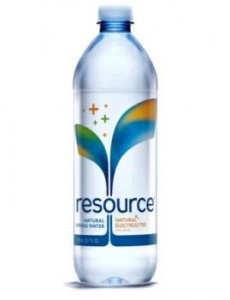 Have you heard of Nestlé’s new product “Resource”? With bottled water a competitive $11.8 billion international industry in 2012 alone, it makes sense that suppliers will work very hard to dress up their products to give them any advantage in the marketplace. Keeping in mind that they’re selling water, they’re doing this by dressing it down: its simpler, more authentic, and there’s green, yellow and blue on the label. “Resource” is so natural, in fact, that you can see right through it, like there’s nothing there. Maybe that’s because they use 50% less plastic in the bottles. How much purer can it get?
Have you heard of Nestlé’s new product “Resource”? With bottled water a competitive $11.8 billion international industry in 2012 alone, it makes sense that suppliers will work very hard to dress up their products to give them any advantage in the marketplace. Keeping in mind that they’re selling water, they’re doing this by dressing it down: its simpler, more authentic, and there’s green, yellow and blue on the label. “Resource” is so natural, in fact, that you can see right through it, like there’s nothing there. Maybe that’s because they use 50% less plastic in the bottles. How much purer can it get?
This premium water, aimed primarily at women–as quoted in the media, the manager for the marketing team has said that their ideal target consumer is “a woman who is a little more on the trendy side and higher-income side, and the bull’s-eye is 35 years old”–is so authentic that it not only helps one to cut through a hectic, noisy world, making annoying people just disappear, but also to soar, like a graceful member of a Cirque du Soleil troupe. Did you see the video from the product launch, just a few weeks ago? The audience is mesmerized.
What I find interesting, though, is the media reaction to the product (“paying extra for ‘high-end’ water is completely ridiculous–honestly, we’re pretty upset that premium water is even a thing at all”). Obviously it’s a scam–elite water? Who would pay $30 for 700 ml of H2O when you can get it from your tap for free? What’s next, oxygen bars? Hand-sharpened, artisanal pencils for, yes, $35 each? Is there no end to people’s gullibility?
But then again, is this not the basis for all commodifiction: to so cleanly sever the price for which one sells something, anything, from both its utility and its production costs (i.e., raw materials, labor, shipping, etc.) that not even the sky is the limit for the profits we can make? Perhaps the marketing behind “Resource” seems a little exaggerated, but it’s hard to imagine a product out there now being sold that’s not using the same techniques: to create an aura of immaterial value (let’s call it prestige) that’s able to justify a price so beyond any obvious use value that, without this very impression, one would feel downright silly buying it.
So, instead of criticizing the easy cases of “ostentatious consumption”–“Resource” or those $35 pencils, for example–it might be more interesting to look at the cases where many more of us take for granted that there really is a right way to use the word artisanal and that there’s an obvious, indisputable benefit to paying extra for the truly finer things of life–e.g., the hand-tossed pizza, the director’s cut of the movie, the thirty year old Scotch, the tailored suit, the first edition in a used book shop, the imported tiles for the kitchen, or maybe even that fine Corinthian leather. For what makes our sense of them as being finer in the first place other than the mesmerizing way in which they are packaged for us? The fact that plain old bottled water, a laughable product not so very long ago, “is even a thing at all”–Americans each drank an average of 30 gallons of it last year–ought to be the first place where we start, actually. Because, at least for some of us on this globe, those with money enough to burn, there really is water, water everywhere…
